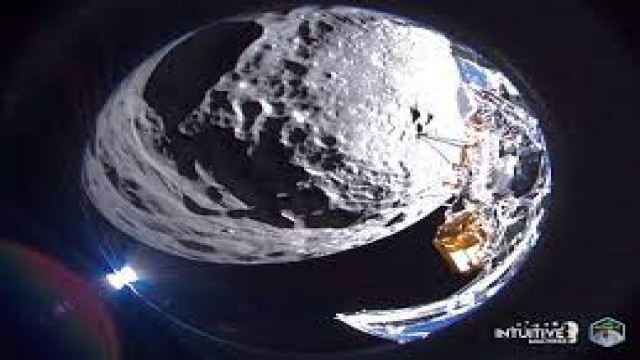Communications were hampered when a private American lunar lander toppled over upon touchdown and wound up on its side close to the moon's south pole, according to company officials on Friday.
After Thursday's touchdown, Intuitive Machines originally thought its six-footed lander, Odysseus, was upright. However, CEO Steve Altemus reported on Friday that the ship "caught a foot in the surface," toppling over and perhaps resting on a rock. He said that it was approaching too quickly and may have broken a leg.
"Even though we're tipped over, we have a good deal of operational capability so far," he told reporters.
However, Altemus noted that some antennae were oriented toward the surface, which hindered flight controllers' capacity to receive data. The 14-foot (4.3-meter) lander's antennae were positioned high to aid with communication in the mountainous, cratered, and shaded south polar area.
Less than 200 miles (300 km) from the south pole, Odysseus, the first American lander in over 50 years, is believed to be a few miles (kilometers) from its planned landing spot close to the Malapert A crater. The primary client, NASA, sought to go as near to the pole as possible in order to survey the region before to the arrival of humans later this decade.
This weekend, as it passes over, NASA's Lunar Reconnaissance Orbiter will make an effort to determine the location of the lander.
Following just five governments, Intuitive Machines made history on Thursday by becoming the first private company to successfully land on the moon. Although its lander also landed on its side last month, Japan was the most recent nation to achieve a touchdown.
NASA provided major funding for Odysseus's expedition, with their experiments being carried out on board. NASA funded the supply with $118 million as part of a program designed to stimulate the lunar economy.
When the lander's navigation system failed to activate, one of the NASA experiments was put into action.
When Intuitive Machines attempted to utilize its lasers to enhance the lander's orbit, it detected the issue beforehand. If not, the breakdown would not have been recognized by flight controllers until five minutes before touchdown, when it would have been too late.
According to mission director Tim Crain, "serendipity is exactly the right word."
It turns out that the device could not be activated in space since a switch was left switched before takeoff.
Odysseus, which was launched last week from Florida, completed an additional round of the moon on Thursday to give NASA's laser system time to kick in at the last minute, which officials said ultimately saved the day.
A cube equipped with four cameras was intended to launch 30 seconds before to Odysseus's arrival in order to take images of the landing. However, because of the navigation switch, Embry-Riddle Aeronautical University's EagleCam was purposefully turned off during the last descent and remained linked to the lander.
According to Troy Henderson of Embry-Riddle, his team plans to make EagleCam available in the next several days so that it may take pictures of the lander from a distance of around 26 feet (8 meters).
Henderson told The Associated Press, "Getting that last image of the lander on the surface is still an incredibly important task for us."
Before lunar twilight arrives, Intuitive Machines expects the solar-powered lander to be in operation for no more than nine or ten days on the moon.
Under NASA's commercial lunar services initiative, the corporation was the second enterprise to set its sights on the moon. Pittsburgh-based Astrobotic Technologies attempted it last month, but the mission was cut short due to a fuel leak on the lander, and the craft ultimately crashed back to Earth.
Since Gene Cernan and Harrison Schmitt's lunar landing on Apollo 17 ended NASA's storied moon landing mission in December 1972, the United States has not made a moon landing until this past Thursday. Apollo's fabled twin sister Artemis serves as the inspiration for NASA's next endeavor to send humans back to the moon. At most, in 2026, the first Artemis personnel landing is scheduled to occur.
End//voice7news.tv































Comment: